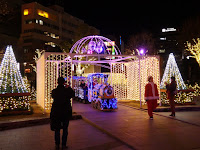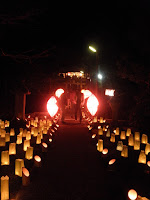December 22, 2016

Japan's 5th largest city lures young families with neat, compact living environment
The park is located amid the fashionable Tenjin district, one of the most bustling areas in Fukuoka City, Kyushu, southwestern Japan, but it used to be a haunt of homeless people with unsafe dark spots here and there. Local business owners and people got together to improve the environment around the park with the help of researchers and designers, and their years of efforts contributed to fully redeveloping it as a comfortable urban park in 2012.
 Kego Park becomes a small illuminated amusement world in the winter time. Visitors enjoy skating and watching various events and shows.
Kego Park becomes a small illuminated amusement world in the winter time. Visitors enjoy skating and watching various events and shows.Kids and their mothers and fathers can also enjoy riding on a colorfully decorated electric train.
Operating the train ride is a team of five young male and female attendants wearing the Santa Claus costume. "We don't have many customers on weekdays, but we are busy all the time every weekend," said one attendant. Charges for the 5-minute ride are 300 yen for kids 5 years old or older and 200 yen for younger kids, with no charge for toddlers.
 "We have to run the train almost uninterruptedly during our service on weekend. Our young passengers sometimes don't like to get off after finishing the ride, and they ask their parents to let them ride more," he said smilingly.
"We have to run the train almost uninterruptedly during our service on weekend. Our young passengers sometimes don't like to get off after finishing the ride, and they ask their parents to let them ride more," he said smilingly. The Kego Park project is a success model of refurbishment in Tenjin in the heart of Fukuoka, as the city's population has grown continuously in recent years. City officials proudly announced in February this year that Fukuoka became Japan's fifth biggest city in 2015, with its population growing 5 percent in the past decade to 1,538,000.
The Kego Park project is a success model of refurbishment in Tenjin in the heart of Fukuoka, as the city's population has grown continuously in recent years. City officials proudly announced in February this year that Fukuoka became Japan's fifth biggest city in 2015, with its population growing 5 percent in the past decade to 1,538,000. Fukuoka, the capital city of Fukuoka Prefecture, follows Yokohama, Osaka, Nagoya and Sapporo in that order.
Fukuoka, the capital city of Fukuoka Prefecture, follows Yokohama, Osaka, Nagoya and Sapporo in that order.The influx of new citizens from around the city is attributed to various reasons, but people familiar with the situation equally cite Fukuoka's compactness as a city.
 Despite its big size, the city has various urban systems and facilities available within an easy reach. Among them are an airport, a subway network, a ball park with a dome, a succor stadium, a bay side amusement area and a scenic seashore. Business areas which accommodate public offices and other buildings and shopping areas are geographically close to each other.
Despite its big size, the city has various urban systems and facilities available within an easy reach. Among them are an airport, a subway network, a ball park with a dome, a succor stadium, a bay side amusement area and a scenic seashore. Business areas which accommodate public offices and other buildings and shopping areas are geographically close to each other. Because many brand businesses have offices and shops in Fukuoka, items and goods newly released in Tokyo quickly become available in the city.
The neat, compact living environment makes Fukuoka even more attractive to young men and women, including those with children.
 Fukuoka's population growth is quite unusual at a time when Japan's society is aging due to a declining birthrate. Its expansion is not an entirely welcome phenomenon, some experts say. Actually, not a few citizens are said to be unenthusiastic about its population growth.
Fukuoka's population growth is quite unusual at a time when Japan's society is aging due to a declining birthrate. Its expansion is not an entirely welcome phenomenon, some experts say. Actually, not a few citizens are said to be unenthusiastic about its population growth. The city's prosperity comes along with years of population decreases in many other parts of Kyushu. Observers also say many big commercial projects in the city center are led by outside capital businesses, noting these projects will not necessarily contribute to boosting the local economy.
The city's prosperity comes along with years of population decreases in many other parts of Kyushu. Observers also say many big commercial projects in the city center are led by outside capital businesses, noting these projects will not necessarily contribute to boosting the local economy.Kego Park is called Tenjin Hikari (light) Square in the winter time, from late November to early January. The facilities and services to be provided during the period are managed by the "We Love Tenjin Council," a group of businesses operating in the Tenjin district.
The illuminated train runs from 3 p.m. to 9 p.m. on weekdays and from 2 p.m. to 9 p.m. on weekend. "Our job is tough but exciting, We can see many kids and parents, and it's fun," said the train attendant.











































